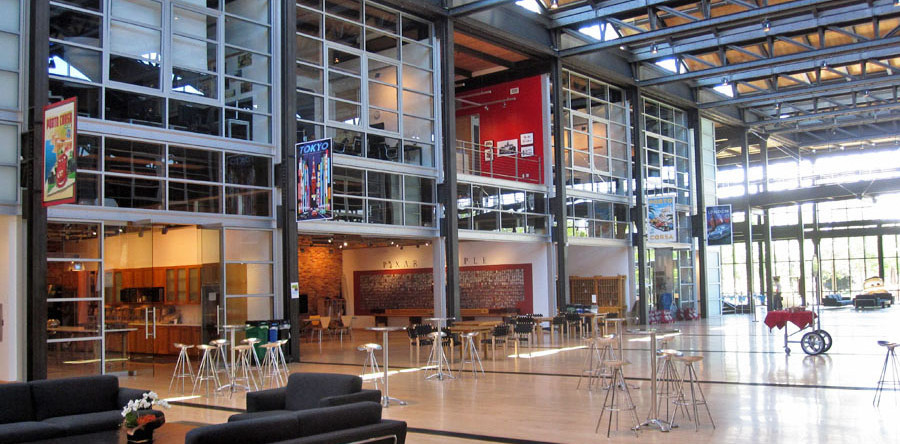When the Second World War ended, universities struggled to cope with record enrollments. Like many universities, the Massachusetts Institute of Technology built a series of new housing developments for returning servicemen and their young families. One of those developments was named Westgate West. The buildings doubled as the research lab for three of the greatest social scientists of the 20th century and would come to reframe the way we think about office spaces.
In the late 1940s, psychologists Leon Festinger, Stanley Schachter, and sociologist Kurt Back began to wonder how friendships form. Why do some strangers build lasting friendships, while others struggle to get past basic platitudes? Some experts, including Sigmund Freud, explained that friendship formation could be traced to infancy, where children acquired the values, beliefs, and attitudes that would bind or separate them later in life. But Festinger, Schachter, and Back pursued a different theory that would go on to shape the thinking of contemporary prophets from Steve Jobs to Google’s Sergey Brin and Larry Page.
The researchers believed that physical space was the key to friendship formation; that “friendships are likely to develop on the basis of brief and passive contacts made going to and from home or walking about the neighborhood.”¹ In their view, it wasn’t so much that people with similar attitudes became friends, but rather that people who passed each other during the day tended to become friends and later adopted similar attitudes.
Festinger and his colleagues approached the students some months after they had moved into Westgate West, and asked them to list their three closest friends. The results were fascinating—and they had very little to do with values, beliefs, and attitudes. Forty-two percent of the responses were direct neighbors, so the resident of apartment 7 was quite likely to list the residents of apartments 6 and 8 as friends—and less likely to list the residents of apartments 9 and 10. Even more striking, the lucky residents of apartments 1 and 5 turned out to be the most popular, not because they happened to be kinder or more interesting, but because they happened to live at the bottom of the staircase that their upstairs neighbors were forced to use to reach the building’s second floor. Some of these accidental interactions fizzled, of course, but in contrast to the isolated residents of apartments 2 and 4, those in apartments 1 and 5 had a better chance of meeting one or two kindred spirits.
Westgate West as Inspiration for Pixar
Half a century passed, and the Westgate West message began to infiltrate office culture. Steve Jobs famously redesigned the offices at Pixar, which originally housed computer scientists in one building, animators in a second building, and executives and editors in a third. Jobs recognized that separating these groups, each with its own culture and approach to problem-solving, discouraged them from sharing ideas and solutions.
Perhaps the animators could introduce a fresh perspective when the computer scientists became stuck; and maybe the executives would learn more about the nuts and bolts of the business if they occasionally met an animator in the office kitchen, or a computer scientist at the water cooler. Jobs ultimately succeeded in creating a single cavernous office that housed the entire Pixar team, and John Lasseter, Pixar’s chief creative officer, declared that he’d “never seen a building that promoted collaboration and creativity as well as this one.”
Google’s “150-Feet From Food” Rule
Google’s New York City campus capitalizes on many of the same ideas. The growing campus already has a massive footprint, occupying an entire floor (and part of some other floors) in a building that covers a city block in Manhattan’s Chelsea neighborhood. The elevators that link these floors are notoriously slow, so instead of forcing workers to wait, the architects built vertical ladder chutes between adjacent floors. Workers are encouraged to “casually collide,” an aim that echoes Jobs’ encouragement of “unplanned collaborations.”
When I visited the campus in March, my guide explained that no part of the office was more than 150 feet from food—either a restaurant, a large cafeteria, or a micro-kitchen—which encourages employees to snack constantly as they bump into coworkers from different teams within the company. Even if Google workers aren’t constantly generating new ideas, plenty of evidence suggests that they enjoy their work, and that this enjoyment feeds into motivation and eventually greater productivity.
Festinger and his colleagues were right to focus on physical space when they explored how friendships form—but what made their investigation doubly impressive was how deeply their insights influenced the corporate world’s smartest thinkers fifty years in the future. People with similar attitudes are more likely to get along, those with diverse backgrounds are more likely to generate novel ideas, but none of those interactions exist without the primary ingredient of casual encounters and unexpected conversations.
The key features that make for a collaborative office space:
- An open plan and other design features (e.g., high-traffic staircases) that encourage accidental interactions.
- More common areas than are strictly necessary—multiple cafeterias, other places to read and work that encourage workers to leave confined offices.
- Emphasis on areas that hold two or more people, rather than single-occupancy offices.
- Purpose-free generic “thinking” areas in open-plan spaces, which encourage workers to do their thinking in the presence of other people, rather than alone.
—
What About Your Workspace?
What office features do you think make for a more collaborative workspace?
Source: 99u








Lorem ipsum dolor sit amet, consectetuer adipiscing elit. Praesent vestibulum molestie lacus. Aenean non ummy hendrerit mauris. Phasellus porta. Fusce suscipit varius mi. Cum sociis sere natoque penati bus et magnis dis. Lorem ipsum dolor. Lorem ipsum dolor sit amet, consectetuer adipiscing elit lorem. Praesent vestibulum molestie lacus. Aenean nonummy hendrerit mauris.
Lorem ipsum dolor sit amet, consectetuer adipiscing elit. Praesent vestibulum molestie lacus. Aenean non ummy hendrerit mauris. Phasellus porta. Fusce suscipit varius mi. Cum sociis sere natoque penati bus et magnis dis. Lorem ipsum dolor. Lorem ipsum dolor sit amet, consectetuer adipiscing elit lorem. Praesent vestibulum molestie lacus. Aenean nonummy hendrerit mauris.
Lorem ipsum dolor sit amet, consectetuer adipiscing elit. Praesent vestibulum molestie lacus. Aenean non ummy hendrerit mauris. Phasellus porta. Fusce suscipit varius mi. Cum sociis sere natoque penati bus et magnis dis. Lorem ipsum dolor. Lorem ipsum dolor sit amet, consectetuer adipiscing elit lorem. Praesent vestibulum molestie lacus. Aenean nonummy hendrerit mauris.